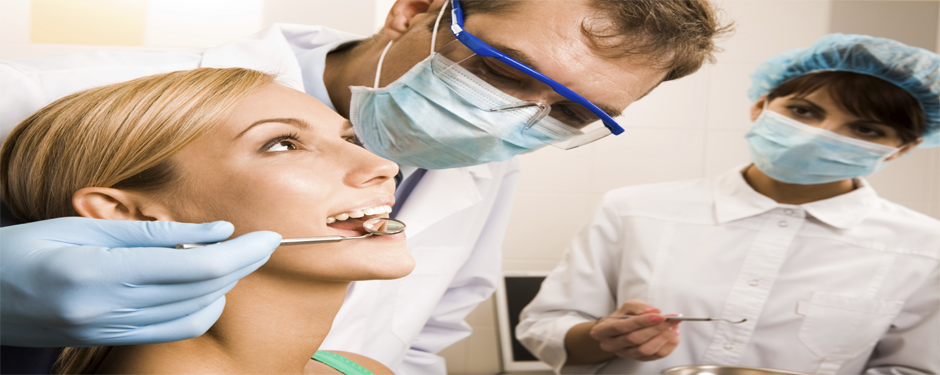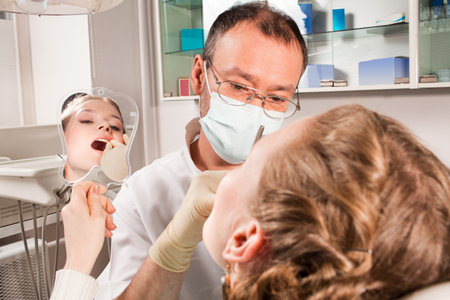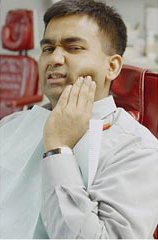Initial Oral Exam
 Your initial oral examination includes a full mouth series of x-rays, a comprehensive oral exam and a routine cleaning. The oral exam includes charting of all your dentition including previous work done as well as any work you might need. We also check your gums and perform a periodontal examination including probing and charting of your pocket depths. In addition we perform an oral cancer screening. Our initial exam covers your entire mouth not just your teeth. Having problems with your TMJ? Dr. Gupta will perform an exam to test how you open and close your mouth.
Your initial oral examination includes a full mouth series of x-rays, a comprehensive oral exam and a routine cleaning. The oral exam includes charting of all your dentition including previous work done as well as any work you might need. We also check your gums and perform a periodontal examination including probing and charting of your pocket depths. In addition we perform an oral cancer screening. Our initial exam covers your entire mouth not just your teeth. Having problems with your TMJ? Dr. Gupta will perform an exam to test how you open and close your mouth.
Bonding
 Bonding is a procedure in which an tooth -like material is applied to a tooth`s surface, sculpted to an ideal shape, hardened, and then polished for an ideal smile. This procedure can be accomplished in a single visit.
When teeth are chipped, cracked or decayed, bonded composite may be the material of choice. Bonding also is used as a tooth-colored filling for small cavities.
Additionally, bonding can be used to close spaces between teeth or to change the color and shape of the tooth. Crowns, also known as caps, are used in cases where other procedures will not be effective.
Bonding is a procedure in which an tooth -like material is applied to a tooth`s surface, sculpted to an ideal shape, hardened, and then polished for an ideal smile. This procedure can be accomplished in a single visit.
When teeth are chipped, cracked or decayed, bonded composite may be the material of choice. Bonding also is used as a tooth-colored filling for small cavities.
Additionally, bonding can be used to close spaces between teeth or to change the color and shape of the tooth. Crowns, also known as caps, are used in cases where other procedures will not be effective.
Bridges

Bridges are a treatment option to replace one or more missing teeth. They are natural-looking dental appliances that you can bite on naturally. Bridges are custom made for each case and are not noticeable to the naked eye. If you opt not to have an implant which is the treatment of choice for a missing tooth or you are not a candidate for implant placement, a bridge is the treatment of choice.
Crowns
 Crowns are artificial caps, usually made of a material such as ceramic or porcelain which covers the top of your tooth.
Crowns are artificial caps, usually made of a material such as ceramic or porcelain which covers the top of your tooth.
Crowns are typically used to restore a tooth following a procedure such as a root canal or if the amount of decay on your tooth is too large for a filling. When decay in a tooth has become so advanced that large portions of the tooth must be removed, crowns are often used to restore the tooth.
Crowns are also used to attach bridges, cover implants, prevent a cracked tooth from becoming worse, or an existing filling is in jeopardy of becoming loose or dislocated. Crowns also serve an aesthetic use, and are applied when a discolored or stained tooth needs to be restored to its natural appearance.
Teeth Whitening
 Whitening or bleaching teeth can completely change the color and brightness of people with stained, dull, or discolored teeth.
Whitening or bleaching teeth can completely change the color and brightness of people with stained, dull, or discolored teeth.
Over time deposits are left on your enamel which are termed extrinsic stains. These deposits can cause the teeth to long yellow brown and even black. Many foods are staining as well as many drinks such as coffe, tea or red wine. Also tobacco can leave severe stains which may not be removed with just a cleaning.
Bleaching the teeth with 35% hydrogen peroxide removes these stains and allows the natural color of the enamel to be revealed. In our practice we take into account that many patients have sensitive teeth. For these patients we treat the teeth with desensitizing materials before and after the procedure in order to minimize any sensitivity.
Bleaching does not remove intrinsic stains caused by problems during development. In order to address those concerns crowns or veneers may be a more viable option.
There are many different methods to bleach your teeth. We can bleach them in one hour in office, make you trays so you bleach them at home overnight for several days or try one size fits all trays for ten days which you only keep in your mouth for 1 hour a day. You can discuss all these options with Dr. Gupta.
More and more people today are choosing tooth-whitening procedures to reverse the effects of aging and abuse from food and tobacco stains.
Invisalign®
 Invisalign®'s invisible, removable, and comfortable aligners will give you the beautiful straight teeth you've always wanted. And best of all, no one can tell you're wearing them. Invisalign is great for adults and teenagers.
Invisalign®'s invisible, removable, and comfortable aligners will give you the beautiful straight teeth you've always wanted. And best of all, no one can tell you're wearing them. Invisalign is great for adults and teenagers.
- Invisalign® is the invisible way to straighten your teeth without braces.
- Invisalign® uses a series of clear, removable aligners to straighten your teeth without metal wires or brackets
- Invisalign® has been proven effective in clinical research and in orthodontic practices nationwide.
How Does Invisalign® Work?
- You wear each set of aligners for about 2 weeks, removing them only to eat, drink, brush, and floss.
- As you replace each aligner with the next in the series, your teeth will move little by little, week by week - until they have straightened to the their final position
- You'll visit us about once every 6 weeks to ensure that your treatment is progressing as planned.
- Total treatment time averages 9 - 15 months and the average number of aligners during treatment is between 18 - 30, but both will vary from case to case.
How Are Aligners Made? You'd Be Amazed...
- The aligners are made through a combination of our expertise and 3-D computer imaging technology.
Root Canal Therapy
 Your initial oral examination includes a full mouth series of x-rays, a comprehensive oral exam and a routine cleaning. The oral exam includes charting of all your dentition including previous work done as well as any work you might need. We also check your gums and perform a periodontal examination including probing and charting of your pocket depths. In addition we perform an oral cancer screening. Our initial exam covers your entire mouth not just your teeth. Having problems with your TMJ? Dr. Gupta will perform an exam to test how you open and close your mouth.
Your initial oral examination includes a full mouth series of x-rays, a comprehensive oral exam and a routine cleaning. The oral exam includes charting of all your dentition including previous work done as well as any work you might need. We also check your gums and perform a periodontal examination including probing and charting of your pocket depths. In addition we perform an oral cancer screening. Our initial exam covers your entire mouth not just your teeth. Having problems with your TMJ? Dr. Gupta will perform an exam to test how you open and close your mouth.
Toothaches

There are several causes of toothaches. It is important to visit the dentist in order to know what the proper treatment will be as the treatment will be dictated by what the problem is. The doctor will ask you questions such as describe the pain or discomfort. It may be feel sharp or dull, when you eat cold foods or all the time, or it can be localized or generalized even causing headaches. The cause of the toothache can also range from cavity, gum problems, or trauma. Trauma can occur by biting into something hard the wrong way. If so many times patients are not even aware. The dentist can not only treat your tooth ache but also give you medication to manage your discomfort and instructions as to take care of the ache.
Botox & Fillers
 Botox and dermal fillers are both cosmetic procedures that address signs of aging, but they work in different ways: Botox relaxes muscles to reduce dynamic wrinkles, while fillers add volume and smooth out static wrinkles and folds
Botox and dermal fillers are both cosmetic procedures that address signs of aging, but they work in different ways: Botox relaxes muscles to reduce dynamic wrinkles, while fillers add volume and smooth out static wrinkles and folds
.png)
